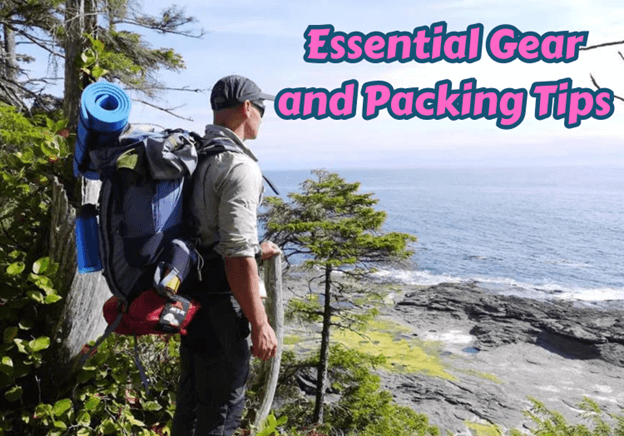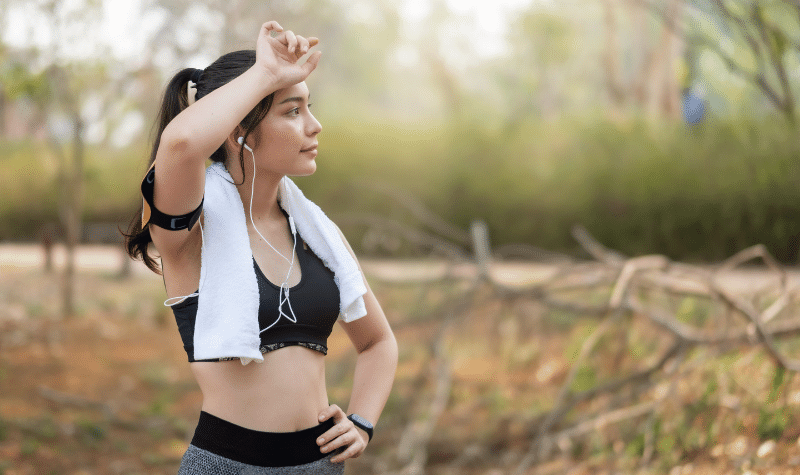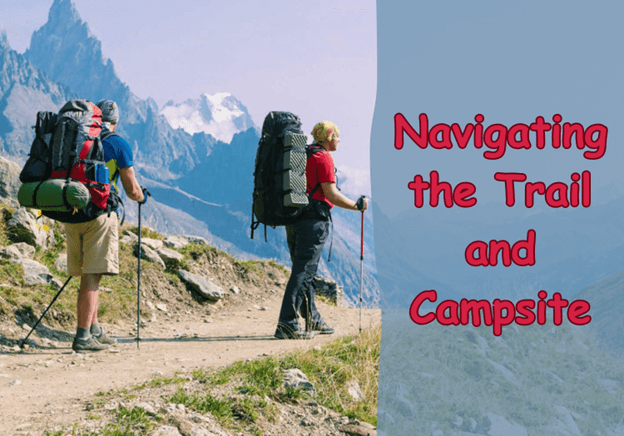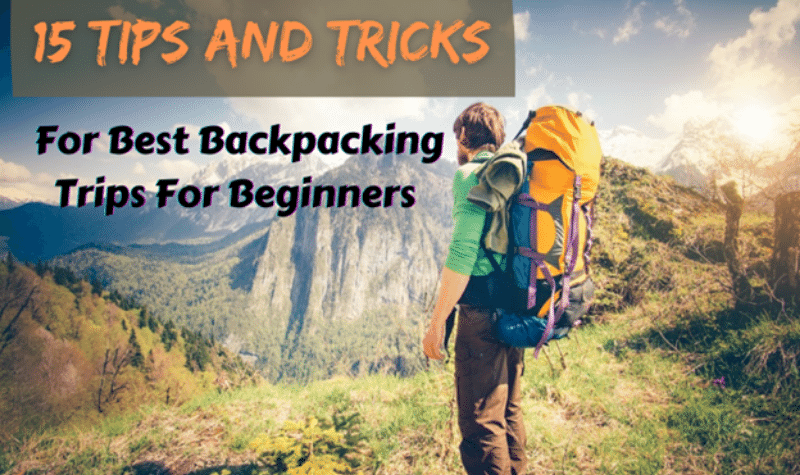Backpacking has caught the hearts of seasoned travelers and beginners alike with its promise of adventure and discovery. Backpacking has grown in popularity among newcomers as more people desire to escape their daily routines and immerse themselves in the beauty of nature. The idea of hiking into nature while carrying everything you need on your back is appealing.
For those new to backpacking, the adventure may be exciting and frightening. The key to a successful and pleasurable backpacking trip is to choose one that matches your talents, tastes, and degree of comfort.
In this article, we’ll go over 15 tips and strategies for the Best Backpacking Trips For Beginners and to help you navigate the fascinating world of backpacking confidently and easily. Whether you’re a nature lover, a curious adventurer, or just someone looking for a change of pace, these tips will help you go on memorable and fulfilling backpacking trips.
Best Backpacking Trips For Beginners-15 Sure Tips And Tricks:
Choosing The Perfect Backpacking Destination:
1. Research And Planning:
Before going on a backpacking trip, do extensive study and preparation. This is the most important phase in planning a great vacation. Use trustworthy resources such as travel guides, online forums, and blogs that provide personal stories and insights from experienced backpackers.
These sites may give useful information on trail conditions, difficulty levels, permits, and hidden treasures. Consider the length of the path, the terrain you’ll experience, and the expected weather conditions during your intended visit. Being well-informed can assist you in selecting a place that matches your talents and interests.
2. Opt for Well-Trodden Paths:
As a beginner, it’s best to stick to trails and routes with a reputation for being beginner friendly. Many hikers have used these paths, and are often well-maintained, lessening the possibility of unforeseen problems.
Consider renowned sites such as national parks, which provide a variety of routes appropriate for hikers of all skill levels. Yosemite National Park, the Great Smoky Mountains National Park, and Rocky Mountain National Park are popular for beginners since they provide stunning scenery and easy trails.
3. Consider Group Tours or Guided Trips:
Joining a group trip or hiring a professional guide is a fantastic alternative for individuals who wish to get into backpacking with additional assistance and instruction. Group trips provide the benefit of safety in numbers and the chance to learn from experienced leaders.
Guides may provide information about the environment, local plants and animals, and trekking skills. You’ll also connect with other novices, share the trip, and make lifelong memories. Many companies conduct scheduled tours for beginners, assuring a well-planned and pleasurable experience.
Starting a backpacking trip is an incredible adventure, and choosing the correct place is critical to ensure your first experience is great. Research, well-established routes, and guided tours will prepare you for a successful and pleasant backpacking journey.
Essential Gear and Packing Tips

4. Choosing the Right Backpack:
Choosing the right backpack is critical in ensuring a successful hiking trip. Consider the length of your vacation as well as your particular preferences. A smaller backpack with a 30-50 liters capacity may be enough for shorter journeys. If you’re going on a multi-day journey, get a bigger pack with a 50-70 liters capacity to accommodate more gear and supplies.
Consider features such as movable shoulder and hip straps for a comfortable fit, various pockets for efficient packing, and a robust frame for improved weight distribution when purchasing a backpack. In addition, to protect your belongings from the weather, ensure the pack is built of robust and water-resistant materials.
5. Packing Light and Smart:
As a general rule, less is more while hiking. Carrying extraneous goods may easily cause tiredness and pain. Focus on the fundamentals for your safety and comfort while packing. Consider the checklist below:
• Clothing: Layer able, moisture-wicking clothing is recommended. Bring a windproof and waterproof outer layer, extra socks, a cap, and a moisture-wicking base layer.
• Shelter: For insulation and comfort, consider a lightweight tent, hammock, or tarp, as well as a comfortable sleeping bag and pad.
• Food: Choose light, high-energy foods such as trail mix, energy bars, and dried meals. If you want to cook, bring a small camp stove and equipment.
• Safety Gear: Pack a first-aid kit, a map and compass or GPS device, a multi-tool, a headlamp with additional batteries, and an emergency whistle as a matter of course.
6. Footwear and Clothing:
Proper footwear and gear are essential for a pleasant hiking experience. Purchase hiking shoes or boots with strong ankle support and a tight fit. Choosing footwear depends on the hills—trail runners for clean paths and robust boots for rough terrain.
When it comes to clothing, layering is a good way to adjust to changing weather conditions. Begin with a base layer designed to wick sweat away from your skin. Add insulating layers such as fleece or down to trap heat. Finally, put a waterproof and windproof outer layer to keep rain and frigid winds at bay.
You’ll be ready for your backpacking trip if you follow these tips for gear and packing. Remember that careful gear selection and smart packing are essential for avoiding strain and enhancing pleasure on your trip.
Preparation and Safety Measures
7. Physical Conditioning:

Preparing your body for the physical demands of backpacking is critical to having a fun and safe trip. A well-rounded workout routine could help develop strength, endurance, and flexibility. To get you started, here’s an easy outdoor fitness routine:
• Cardiovascular Conditioning: To increase your cardiovascular fitness, engage in brisk walking, running, cycling, or swimming.
• Strength Training: Concentrate on workouts that work the core, legs, and upper body. Body weight workouts such as squats, lunges, push-ups, and planks are useful.
• Stretching and Flexibility: Include yoga or simple stretching practices to promote flexibility and avoid muscular tightness.
• Balance and Stability: Do balance exercises such as standing on one leg or completing balancing postures to increase stability on uneven terrain.
8. First Aid and Medical Essentials:
Carrying basic medical supplies is vital for treating minor injuries and illnesses while on the trail. As a beginning, the following things should be in your first aid kit:
• Various sizes of adhesive bandages
• Sanitary gauze pads and sticky tape
• Antibacterial wipes or solution
• Tiny scissors and tweezers
• Pain relievers (ibuprofen, acetaminophen)
• Antihistamines for allergic reactions
• Anti-diarrhea medicine
• Treatment for blisters (moleskin, blister pads)
• Sunscreen and sun-protective lip balm
• Insect repellent
• Personal prescription medications
• Any personal medicinal products (for example, an EpiPen)
Consider completing a basic first aid course before starting on your camping trip. These courses teach you how to react to common injuries and crises, giving you the confidence to deal with unforeseen events. Knowing how to provide first aid may make a big difference to your safety and those around you.
You’re making critical efforts to improve your safety and pleasure of backpacking by including physical fitness and being well-prepared with appropriate medical supplies. Remember that careful planning adds to a more pleasurable and stress-free outdoor trip.
Navigating the Trail and Campsite

9. Basic Navigation Skills:
Learning fundamental navigation skills is critical for a safe and pleasant backpacking trip as a beginner. Here’s where to begin:
• Map Reading: Familiarize yourself with topographic and trail maps of your intended location. Learn to recognize important features like landmarks, elevation variations, and water sources. This information will help you keep on track when hiking.
• GPS Devices: If you use a GPS device, know how to set waypoints, monitor your path, and analyze the data it delivers. GPS gadgets may be useful for monitoring your progress and pinpointing your whereabouts.
• Trail Markers: Signs, blazes, cairns (stacked rocks), and other markers designate many paths. Check for these signs to guarantee you’re on the correct track.
Remember that depending completely on electronic gadgets, even with advanced technology, might be dangerous owing to battery life and signal availability. A well-rounded method requires paper maps and basic navigation abilities.

10. Setting Up Camp:
Backpacking requires the construction of a pleasant and effective campsite. To correctly set up your campground, follow these steps:
• Choosing a campground: If available, choose a dedicated campground. If not, adhere to Leave No Trace standards by camping at least 200 feet away from lakes and streams and using a durable surface, such as existing paths or campgrounds. Keep away from vulnerable ecosystems and animal habitats.
• Setting up a Tent: Find a level area for your tent and remove any rocks or rubbish. To protect the tent floor, spread out your groundsheet or footprint. Set up your tent according to the manual, ensuring it is well-staked and protected from the wind.
• Gear Arrangement: Arrange your belongings inside the tent to optimum space and accessibility. Keep essentials such as your torch, water bottle, and additional clothing close at hand.
• Food Storage: Keep your food in a safe location to avoid attracting animals. Use bear canisters or hang food from a tree limb at least 10 feet from the ground and 6 feet away from the trunk if required.
• Considerations for Campfires: Check your state’s laws about campfires. Campfires are restricted in many areas owing to environmental concerns. If fires are permitted, utilize specified fire rings and keep the fire as small as possible.
You’ll improve your ability to traverse the route and get a good night’s sleep by learning basic navigation skills and how to set up a campsite properly. These skills not only help your safety but also guarantee that you have a low environmental effect and appreciate the beauty of nature.
Food and Cooking Tips
11. Meal Planning:
Proper food preparation is essential for properly feeding your hiking trip. Consider the following suggestions while preparing your meals:
• Nutritional Requirements: Aim for a combination of carbs, proteins, and healthy fats to keep you going on the course. Pack meals high in calories and nutrients to keep you going.
• Choose meals that take the least amount of preparation and cooking time. Dehydrated foods, quick oatmeal, energy bars, and trail mix are excellent choices.
• Easy and light meal ideas include quick spaghetti meals, couscous with dehydrated veggies, nut butter and tortilla wraps, and dehydrated soups. For snacks, dried fruits, nuts, and seeds.
• Cooking Equipment: Purchase a lightweight camping stove as well as utensils. Consider canister stoves or tiny wood-burning stoves as alternatives. Look for lightweight traveling pots, pans, and utensils.

12. Safe Food Handling:
Proper food management is not only important for human health, but it is also important for animals and the environment:
• Food Storage: Keep your food well-sealed in odor-proof containers or bear canisters to avoid attracting animals. Never keep food in your tent; instead, utilize approved storage rooms if they are available.
• Pack It In: Plan your meals ahead of time to reduce food waste. All food crumbs, garbage, and packaging should be removed. Leave no trace by following the rule of “pack it in, pack it out.”
• Wash Your Hands: Make sure your hands are clean before handling food. If you must wash your hands or dishes near water, use biodegradable soap and water from at least 200 feet away.
• Leave No Trace: When disposing of food waste, stick to the Leave No Trace guidelines. Food particles should be strained from dishwater and scattered away from water sources.
You’ll be well-fueled and responsible while camping by carefully planning your meals, bringing healthy and lightweight food, and following proper food handling techniques. Remember that effective food management not only improves your enjoyment but also helps to preserve the natural environment.
13. Interacting with Nature Responsibly
Leave No Trace is a set of principles aimed to help outdoor enthusiasts reduce their environmental effects while conserving nature’s beauty and safeguarding animal habitats. The relevance of the seven Leave No Trace principles is as follows:
1. Plan and Prepare: Proper preparation decreases the chance of crises, assures your safety, and aids in preventing environmental harm.
2. Travel and Camp on Durable Surfaces: Follow the established pathways and campgrounds to prevent trampling plants and causing soil erosion.
3. Proper Waste Disposal: Pack garbage, leftover food, and litter. Use existing toilet facilities or dig a shallow hole at least 200 feet away from water sources for human waste disposal.
4. Leave What You Find: Don’t damage flora, animals, or historical or cultural items. Leave rocks, trees, and other natural features in their original state.
5. Reduce the Impact of Campfires: Campfires may scar the environment and add to fire danger. Instead of creating fires, use a camp stove for cooking and warmth.
6. Respect Wildlife: Keep a safe distance from animals and avoid feeding them. Human feeding has the potential to hurt animals and disturb natural activities.
7. Be Mindful of Other Visitors: Keep noise levels down and share the path with others. Maintain a pleasant and courteous demeanor toward your fellow hikers and campers.
Stick with existing muddy or rainy paths to avoid broadening the track and creating erosion. Using a camp stove instead of fire decreases the effect on local ecosystems and the chance of starting an uncontrolled fire.
All trash must be removed from the premises, including food containers and used toilet paper. Maintain a safe distance from animals, preventing them from approaching nesting locations or offering them human food. If available, choose approved campgrounds built to endure the stress of camping.
Following these Leave No Trace rules and minimizing your environmental effect helps preserve our natural landscapes and guarantee future generations may enjoy the outdoors.
Overcoming Common Challenges

14. Dealing with Adverse Weather:
Mother Nature can be unexpected, and trekkers must be equipped to deal with adverse conditions.
To remain dry, always bring a lightweight waterproof jacket and leggings. Pack your belongings in waterproof stuff sacks or dry bags to keep the dampness out. Wear quick-drying garments to avoid discomfort from damp clothes.
Light, loose-fitting clothing that covers most of your skin is best for hot weather. For sun protection, wear a wide-brimmed hat and sunglasses. Drink lots of water and rest regularly in shady locations to stay hydrated.
Layering is essential in chilly weather. Wear moisture-wicking base layers, insulating mid layers, and an outer and windproof layer. Remember to bring gloves, a hat, and warm socks. Continue to move to create body heat, and consume warm liquids and high-energy foods.
15. Mental Preparedness:
Backpacking causes physical as well as mental stress. Be ready to adjust to shifting conditions. Weather, trail conditions, and unexpected incidents all affect the experience. Recognize that backpacking may be physically taxing. Accept that difficulties will happen but that they can be conquered with determination.
Stay present and focused by practicing mindfulness. Observe the sights, sounds, and fragrances around you to engage your senses. This may assist in alleviating tension and improve your entire experience.
When met with difficulties, remember why you set out on this trip in the first place. Celebrate minor victories and remember that each step brings you closer to your goal.
Spend time in nature to mentally recharge. Find comfort in the natural beauty and the feeling of success that comes from completing paths.
Backpacking is more than a physical adventure; it is a chance to push yourself, gain resilience, and enhance your mental fortitude. You may overcome problems and get more enjoyment from your experience by being adaptive, exercising mindfulness, and having a happy attitude.
Additional Resources
If you are looking for more tutorials, walkthroughs and troubleshooting about camping and enjoying the outdoors, here are some additional posts to check out:
Conclusion
With these 15 professional tips in mind, your first backpacking trip is sure to be one you’ll always remember lovingly. With the correct planning and mentality, you’ll be well on your way to tackling beautiful paths and waking up to breathtaking vistas.
The trick is to get into things gradually and only take on what you can handle initially. Take your time planning, carry light, and choose an easy path. Take it all in once you’re there. Leave your concerns at home and seize the chance to detach from the daily grind.
Be gentle to yourself while challenging yourself. You can do it! Now go out there and start recording trail miles. The vast road is reaching out to you. Thanks for reading, If you think I forgot something or if you simply want to share a story or some advice, feel free to leave your comment below. Be safe and happy backpacking.!

